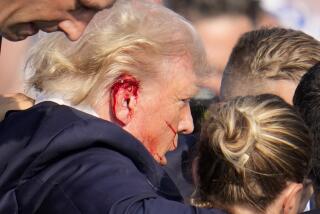Crew Contradicted Kerry Over Battle, Doctor Alleges
- Share via
WASHINGTON — A former Navy doctor who says he treated Sen. John F. Kerry for the wound that led to his first Purple Heart in Vietnam said Tuesday that several of Kerry’s crewmates told medical personnel at the time that the injury did not occur in battle.
Dr. Louis Letson, a retired Alabama physician who served as Medical Officer at the Naval Support Facility at Cam Ranh Bay, said the crew’s story contradicted Kerry’s report in December 1968 that he was wounded during a river firefight between his swift boat and Viet Cong gunmen ashore.
The doctor’s account surfaced Tuesday as part of a barrage of criticism of Kerry by former swift gunboat officers who gathered in Washington to press the likely Democratic nominee to authorize the release of his wartime records.
Kerry did not respond directly, but campaign officials angrily dismissed Letson’s account and questioned why another medical official’s signature appeared on Kerry’s own records of his treatment for the wound. The Kerry campaign also said it had already posted online a copy of all official documents Kerry received from the Navy in his military file.
“If these people have different recollections 35 years later of what they saw or signed, they ought to take it up with the U.S. Navy,” Kerry spokesman Michael Meehan said.
Several of Kerry’s former swift boat crewmates also appeared in Washington to defend the Massachusetts senator. Drew Whitlow, an Arkansas man who served as rear gunner on one of the swift boats Kerry commanded, said that although critics were “entitled to their opinions,” “I served alongside of the man. I know exactly what he was like. And I know the integrity and compassion he had.”
In an e-mailed account of his recollection of Kerry’s treatment and in two phone interviews, Letson said Kerry, then a Navy lieutenant, appeared in the medical tent at Cam Ranh Bay on December 3, 1968, with a slight wound “covered with a Band aid.”
“There wasn’t much blood to it,” he said. “It looked like a splinter.”
Letson described a “small piece of metal sticking very superficially in the skin of Kerry’s arm. The metal fragment measured about 1 centimeter” and did “not look like a round from a rifle,” he said. Letson said he “simply removed the piece of metal” with forceps.
Letson said by phone that the wound was “pretty rare.” “I don’t remember treating any other shrapnel wounds at Cam Ranh Bay,” he said.
Meehan questioned Letson’s role, saying a J.C. Carreon signed Kerry’s medical report of the wound. “This gentleman is not the man who is on the report,” he said.
Letson said Carreon, a lower-ranking “hospitalman,” was “present at the time and he, in fact, made the entry into Lt. Kerry’s medical record which has only recently been made available to the public.” Letson, 63, was a Navy lieutenant as well as a medical officer at the time.
In several accounts, Kerry has said he was wounded by a piece of shrapnel as he and his crew engaged Viet Cong fleeing their boats on the beach. Kerry has said he was uncertain where the shrapnel came from.
The U.S. military’s regulations on issuing a Purple Heart require that an injury is received during “action against an enemy of the United States.”
According to Letson, Kerry told him during his visit to the medical tent that his crew “had been engaged in a firefight, receiving small arms fire from on shore. He said that his injury resulted from this enemy action.” Letson said he did not recall Kerry’s demeanor being “anything out of the ordinary.”
Later, Letson said, several of Kerry’s crew members told a different version to medical personnel: “They did not receive any fire from shore,” he wrote, “but said that Kerry had fired a mortar round at close range to some rocks on shore. The crewmen thought that the injury was caused by a fragment ricocheting from that mortar round when it struck the rocks.”
Letson added that the crew’s account “seemed to fit the injury.” Kerry’s crewmen were “just talking to my guys,” he said by phone. “It was just casual discussion. Up until that point, I didn’t have any suspicions about it, but after I heard that, the circumstances sounded a little unusual. That’s why I remembered it all this time.”
Letson said he played no role in the Navy’s decision to award Kerry his first Purple Heart. “I didn’t even know he got a Purple Heart for it until years later,” he said.
On Tuesday, nearly two dozen former swift boat commanders appeared at the National Press Club to disparage Kerry’s war performance and his leadership role in the antiwar movement after he returned from Vietnam.
The group, Swift Boat Veterans for Truth, was organized by former Rear Adm. Roy F. Hoffmann and John O’Neill, a Dallas lawyer who commanded a Navy gunboat during the war.
O’Neill debated Kerry over the Vietnam War on TV in 1971 after a march organized by Vietnam Veterans Against the War, and was cheered on by President Nixon. He said Kerry “exaggerates the small record he established.”
Hoffmann, who headed a command of 3,000 officers and enlisted men in 1968 and 1969, belittled Kerry as a “loose cannon” chafing under his command.
Meehan and other Kerry aides questioned the timing of the group’s emergence just as the Kerry campaign was launching a $25-million television ad campaign based on his Vietnam War record -- which, in addition to three Purple Hearts, included a Silver Star and Bronze Stars won for battlefield heroics.
Kerry aides cited O’Neill’s “Republican ties” and charged that Spaeth Communications, a Dallas public relations firm that organized the meeting, also had ties to Bush and the Republicans.
More to Read
Sign up for Essential California
The most important California stories and recommendations in your inbox every morning.
You may occasionally receive promotional content from the Los Angeles Times.










